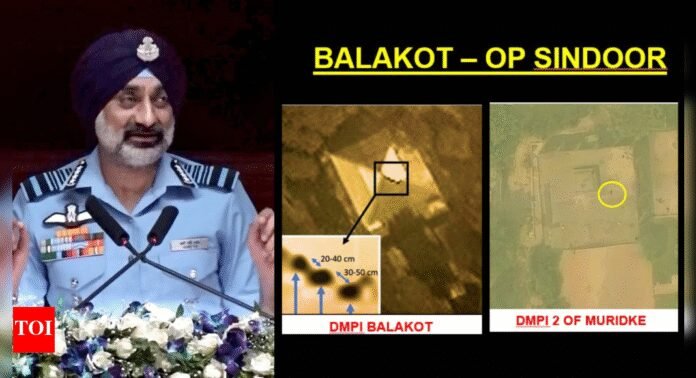NEW DELHI: Haunted by the “ghosts of Balakot”, IAF chief Amar Preet Singh on Saturday came fully armed with more visual proof of the precision airstrikes carried out deep inside Pakistan during Operation Sindoor, showcasing the extent of damage inflicted on key military and terror infrastructure. From high-value airbases to the headquarters of ISI-backed terror outfits, the strikes, conducted in retaliation to the Pahalgam killings, demonstrated India’s ability to hit strategic targets with pinpoint accuracy, well inside enemy territory.“I’m very happy that this time we were able to take care of that ghost of Balakot that we were able to tell the world what we have achieved,” the IAF chief remarked.The evidence included images and videos of the destruction of Pakistan’s Nur Khan Airbase in Rawalpindi, the flattening of Jaish-e-Mohammed’s command centre in Bahawalpur, and crippling damage to Lashkar-e-Taiba’s headquarters in Muridke. The IAF also presented proof of severe hits on the Rahim Yar Khan, Sukkur, and Bholari airbases.
Nur Khan airbase
The strikes inflicted a significant setback on Pakistan’s military capabilities by destroying the Nur Khan Airbase, a key pillar of the country’s air power, during precision strikes under Operation Sindoor. Located in Rawalpindi and formerly known as PAF Chaklala, the base served as the command hub of Pakistan’s Air Mobility Command. It housed critical aerial assets such as Saab Erieye airborne early warning aircraft, C-130 transport planes, and IL-78 aerial refuelling tankers.
Bahawalpur: JeM headquarters
IAF’s precision strikes under Operation Sindoor caused tremendous damage to Jaish-e-Mohammed’s headquarters in Bahawalpur, Pakistan, the ISI-backed terror group’s main command hub.Among those killed were ten members of JeM chief Masood Azhar’s family, marking a major blow to the group’s leadership.
Carried out nearly 100 kilometres inside Pakistani territory, the strike was described as the most powerful of the operation, employing India’s most potent weapon. In total, the armed forces eliminated nine terror launchpads, but the Bahawalpur hit was considered the most significant for both strategic and symbolic reasons.
Muridke: LeT headquarters
Another key terror site that IAF had targeted was Muridke, where Lashkar-e-Taiba’s headquarters was located.Demonstrating the level of damage caused by the strikes, IAF chief said, “This is their senior leadership’s residential area. These were their office building where they would get together to conduct meetings. We could get video from the weapons themselves as the location was within range.”The strikes killed around a dozen high-value terrorists in Pakistan, including IC-814 hijacker Yusuf Azhar, Lashkar’s Muridke chief Abu Jundal alias Mudassar, and the son of the 2016 Nagrota attack plotter.
Rahim Yar Khan airbase
The damages at the Rahim Yar Khan airbase from Operation Sindoor was so intense that it remained non-operational for at least two months. The base, located about 230 km south of Bahawalpur, is a key element of Pakistan’s southern air defence due to its proximity to India’s Rajasthan border and was heavily damaged in India’s precision strikes in early May. Situated within an international airport, the airbase first issued a Notam on May 10, closing the runway until May 18, which was later extended. Another closure notice followed in early June, pushing the date to July 4.
Sukkur airbase
The image shows the before and after scenes at Sukkur Pakistani airbase. Its dual-use radar was targeted as it is located very close to Rajasthan and used for nefarious activities.
Bholari airbase
At Bholari, strikes targeted the AEW&C hangar.“We attacked three hangars. One was the Sukkur UAV hangar, the Bholari hangar and the Jacobabad F-16 hangar. We have an indication of at least one AEW&C in that AEW&C hangar and a few F-16s, which were under maintenance there,” IAF chief said.









